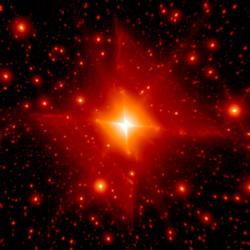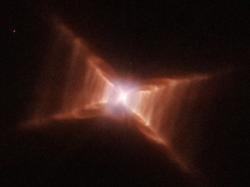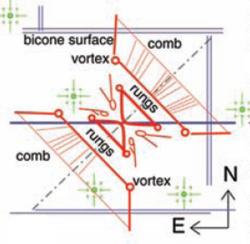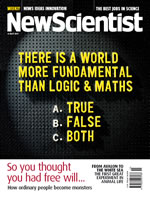



A newly discovered nebula, called the 'Red Square', displays a dazzling, gem-like symmetry, new observations reveal. But the nature of the star or stars that produced it remains a mystery.
Towards the end of their lives, many low-mass stars, like the Sun, slough off their outer layers to produce striking 'planetary' nebulae. But the hot star at the heart of the Red Square nebula, called MWC 922, appears to be relatively massive, suggesting another process formed its signature shape.
"How did all this beautiful, crisp structure form?" asks Peter Tuthill of the University of Sydney in Australia. "This is the million dollar question."
He and colleague James Lloyd of Cornell University in Ithaca, New York, US, found and studied the nebula using the Hale Telescope at Palomar Observatory in California and the Keck II telescope in Hawaii, both in the US. The high resolution needed to make the observations was made possible thanks to adaptive optics, systems that help compensate for blurring due to the Earth's atmosphere.
Tuthill says not one but two stars may be responsible for the nebula. If one of the pair is losing material, the gravity of both stars may pull the matter into a dense disc surrounding both of them.
This would force light and matter to escape from the system from the 'poles' of this disc, explaining why the nebula is shaped like two cones whose tips are touching. Watch an animation showing the structure from different angles.
The yellowish-orange lines that appear to band the cones close to the centre of the image may be the result of a particularly strong but brief outburst from the star that is shedding material. The outbursts may expel matter into space like smoke rings, Tuthill told New Scientist.
The researchers are particularly interested in the faintly discernible comb-like fringes at the outer edge of each cone (see diagram below right).
"Structures such as this are rarely seen in nebulae," says Lloyd. "The high degree of regularity in this case may point to the intriguing possibility that these bands are shadows cast by periodic ripples or waves on the surface of an inner disc close to the star at the heart of the system."
Similar physics may have produced another nebula called the Red Rectangle (below right), which is less symmetrical than its newly found cousin. The Red Square appears to have an almost ideal orientation on the sky, from Earth's vantage point, to produce a symmetric appearance.
Journal reference: Science (vol 316, p 247)

 17:41 13 April 2007
17:41 13 April 2007